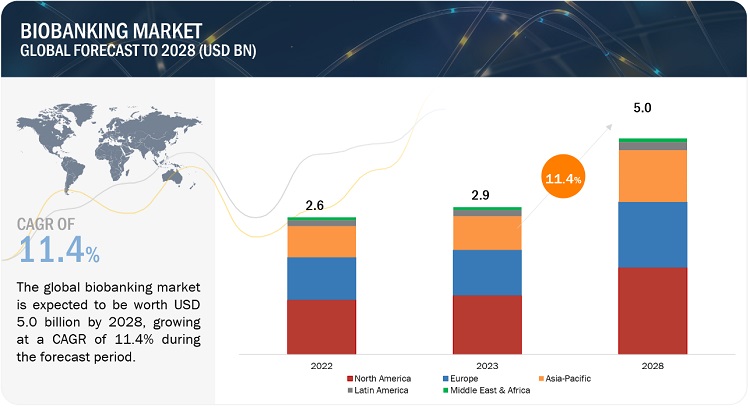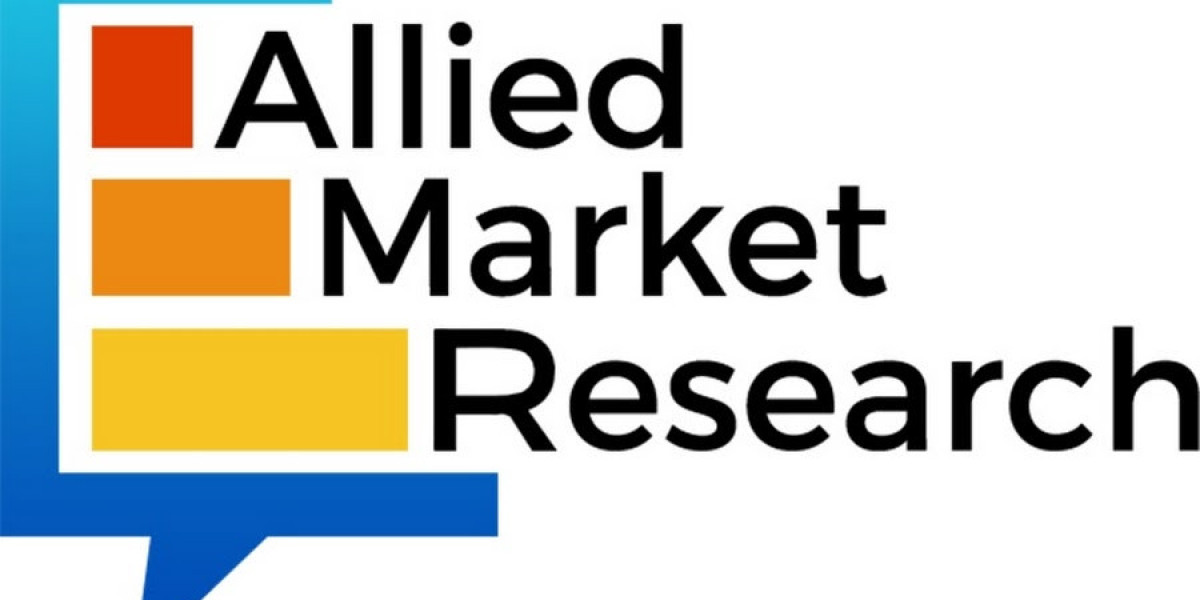The report "Biobanking Market by Product Service (Equipment, Consumable, Services, Software), Sample Type (Blood, Tissue, Nucleic Acids, Cell lines), Ownership, Application (Regenerative Medicine, Life Science, Clinical Research), End User - Global Forecast to 2028", is projected to reach USD 5.0 billion by 2028 from USD 2.9 billion in 2023, at a CAGR of 11.4% during the forecast period of 2023 to 2028.
Browse in-depth TOC on "Biobanking Industry"
334 - Tables
48 - Figures
398 – Pages
 Download PDF Brochure:
Download PDF Brochure:
https://www.marketsandmarkets.com/pdfdownloadNew.asp?id=594
The global biobanking market is expected to grow at a CAGR of 11.4% during the forecast period. The growth of this market is driven by increasing number of private cord blood banks has led to a rise in competition among biobanks, which has driven innovation and improvements in the quality of biobanking services. This, in turn, has fueled growth in the biobanking market as more companies seek to enter this expanding field and meet the growing demand for cord blood stem cell preservation.
The blood products segment accounted for the largest share, by sample type in the biobanking market in 2022.
Based on sample type, the global biobanking market has been segmented into blood products, human tissues, nucleic acids, human waste products, cell lines, and biological fluids. The blood products segment held the largest share of the global biobanking market in 2022. This can be attributed to the rising incidence of blood disorders and the increasing demand for various types of blood products across the globe. With the ongoing expansion of biobanks and the increasing emphasis on precision medicine, the demand for blood products in biobanking is expected to remain strong, further propelling the growth of the global biobanking market
The manual storage segment accounted for the largest share of the storage type segment in the biobanking industry in 2022.
Based on storage, the global biobanking market has been segmented into manual storage and automated storage. The manual storage segment held the larger market share in 2022. The large share of this segment can be attributed to the low cost and easy installation associated with this type of storage. Furthermore, many research centers and life science companies rely on manual processes for biological sample storage, this is further accelerating the market growth.
The North America region catered the largest share of the biobanking market in 2022.
The biobanking market in North America has experienced significant growth in recent years, showcasing a robust expansion trajectory. This can be attributed to the increasing number of biobanks and the growing investments in biobanking infrastructure. Major healthcare institutes and research organizations in North America have made substantial commitments to expanding their biobanking capabilities. Additionally, the rising prevalence of chronic diseases and the subsequent demand for personalized medicine has fueled the growth of the biobanking market in North America, with biobanks playing a pivotal role in storing and providing high-quality biological specimens for research and development purposes.
Key players in the biobanking market include Thermo Fisher Scientific, Inc. (US), PHC Holdings Corporation (Japan), Becton, Dickinson and Company (US), QIAGEN N.V. (Germany), Merck KGaA (Germany), Avantor, Inc. (US), Cryoport, Inc. (US), Tecan Trading AG (Switzerland), Azenta, Inc. (US), Greiner Holding AG (Austria), Hamilton Company (US), Micronic (Netherlands), AMSBIO (UK), Bay Biosciences LLC (US), BioKryo (Germany), SPT Labtech (UK), ASKION GmbH (Germany), CellCo BioServices (France), Ziath Ltd. (UK), CTIBiotech (France), Cureline (US), Firalis Group (France), Sopachem (Netherlands), ProteoGenex (US), and US Biolab Corporation, Inc. (US).
Request Free Sample Pages:
https://www.marketsandmarkets.com/requestsampleNew.asp?id=594
Biobanking Market: Impact Analysis
Drivers
- Growing investments and funding for biobanks
- Focus on genetic testing and precision medicine
- Increasing trend in preservation of cord blood stem cells from newborns
- Favorable funding scenario for research related to regenerative medicine
Restraints
- High cost of automated equipment
- Issues related to biospecimen sample management
- OPPORTUNITIES
Challenges
- High operational cost of biobanks
- Storage of samples
Recent Developments
- In February 2023, PHC Corporation of North America launched the PHCbi Brand VIP ECO SMART Ultra-low Temperature Freezer with industry-leading energy efficiency.
- In September 2022, Cryoport entered into a strategic partnership with BioLife Plasma Services to offer supply chain solutions and service offerings, such as bioservices and cryo-processing, for BioLife Plasma Services.
Biobanking Market Advantages:
- Valuable Research Resources: Biobanks provide researchers with access to a vast collection of well-characterized biological samples and associated data. These resources serve as a valuable foundation for conducting various types of research, including genomics, proteomics, metabolomics, and epidemiological studies. Biobanks enable researchers to investigate diseases, discover new biomarkers, study genetic variations, and develop personalized therapies.
- Accelerating Drug Discovery and Development: Biobanks play a crucial role in the drug discovery and development process. By providing researchers and pharmaceutical companies with access to diverse and representative samples, biobanks facilitate the identification of drug targets, testing of potential therapies, and assessment of drug efficacy and safety. This accelerates the drug development timeline, reduces costs, and enhances the success rate of clinical trials.
- Facilitating Personalized Medicine: Biobanks contribute to the advancement of personalized medicine, which aims to provide tailored healthcare based on an individual's unique genetic makeup and other factors. By storing genetic information, clinical data, and biological samples, biobanks enable the identification of genetic markers associated with diseases, predicting disease risks, and guiding personalized treatment decisions. This helps healthcare providers deliver targeted therapies and improve patient outcomes.
- Long-Term Sample Preservation: Biobanks employ specialized techniques and infrastructure to ensure the long-term preservation of biological samples. This enables the availability of high-quality samples over extended periods, allowing researchers to conduct longitudinal studies, analyze disease progression, and investigate long-term health outcomes. Long-term sample storage also enables retrospective studies and future research on emerging diseases or new research questions.
- Collaboration and Data Sharing: Biobanks promote collaboration and data sharing among researchers, institutions, and industries. By establishing standardized protocols, ethical guidelines, and data sharing agreements, biobanks facilitate the exchange of samples, data, and knowledge. This collaboration fosters scientific discoveries, enables the replication of research findings, and maximizes the utility of stored samples.
- Advancing Translational Research: Biobanks bridge the gap between basic research and clinical applications by facilitating translational research. By linking biological samples to clinical data, biobanks support the investigation of disease mechanisms, biomarker discovery, and the development of diagnostic tests. This enhances the translation of scientific knowledge into clinical practice, leading to improved disease diagnosis, prognosis, and treatment.
Get 10% Free Customization on this Report:
https://www.marketsandmarkets.com/requestCustomizationNew.asp?id=594
About MarketsandMarkets™
MarketsandMarkets™ provides quantified B2B research on 30,000 high growth niche opportunities/threats which will impact 70% to 80% of worldwide companies’ revenues. Currently servicing 7500 customers worldwide including 80% of global Fortune 1000 companies as clients. Almost 75,000 top officers across eight industries worldwide approach MarketsandMarkets™ for their painpoints around revenues decisions.
Our 850 fulltime analyst and SMEs at MarketsandMarkets™ are tracking global high growth markets following the "Growth Engagement Model – GEM". The GEM aims at proactive collaboration with the clients to identify new opportunities, identify most important customers, write "Attack, avoid and defend" strategies, identify sources of incremental revenues for both the company and its competitors. MarketsandMarkets™ now coming up with 1,500 MicroQuadrants (Positioning top players across leaders, emerging companies, innovators, strategic players) annually in high growth emerging segments. MarketsandMarkets™ is determined to benefit more than 10,000 companies this year for their revenue planning and help them take their innovations/disruptions early to the market by providing them research ahead of the curve.
MarketsandMarkets’s flagship competitive intelligence and market research platform, "Knowledgestore" connects over 200,000 markets and entire value chains for deeper understanding of the unmet insights along with market sizing and forecasts of niche markets.
To find out more, visit www.MarketsandMarkets™.com or follow us on Twitter, LinkedIn and Facebook.
Contact:
Mr. Aashish Mehra
MarketsandMarkets™ INC.
630 Dundee Road
Suite 430
Northbrook, IL 60062
USA : 1-888-600-6441
Email : [email protected]
Research Insight: https://www.marketsandmarkets.com/ResearchInsight/biobanking-devices-market.asp
Visit Our Website: https://www.marketsandmarkets.com/
Content Source: https://www.marketsandmarkets.com/PressReleases/biobanking-devices.asp



